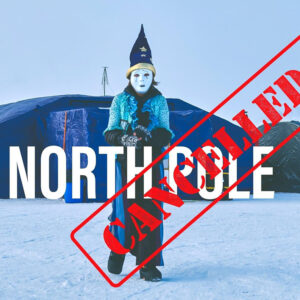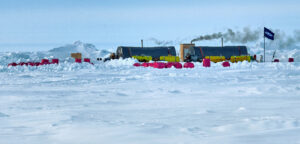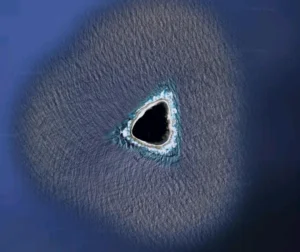Researchers found the famous arctic explorer’s ship in 2014, raising hopes of solving this Northwest Passage expedition’s mysterious end.
Seven years ago, one of the most significant archaeological discoveries in arctic history turned up in a shallow, island-studded region south of King William Island, in the Canadian High Arctic: the wreck of HMS Erebus, Sir John Franklin’s long-lost ship. It lay in 11m down in Queen Maud Gulf, and on clear, calm days, when the water was not turbid, you could see the vessel.
For those unfamiliar with the Franklin saga: In 1845, the 59-year-old British naval officer led a search for the fabled Northwest Passage. When two years passed with no word from Franklin, the searches began. Finding Franklin was one of the great cause célèbres of the age. As time went on, it became clear that Franklin and all 129 men on two ships had perished. Searchers turned up many tantalizing clues, but Franklin’s fate has never been satisfactorily resolved.


The Northwest Passage is not one route, but several. However, the route in red is usually the one that best avoids sea ice. Had Franklin (coming from the north and east) gone that way, he likely would have made it through. Instead, his ships rounded the northern tip of King William Island and started down the west side. Almost immediately, they were beset.
The Arctic is so vast that even with such modern technology as side-scan sonar, finding two small ships in that labyrinth of channels and islands and bays was almost impossible. But using a mix of past clues, contemporary research, and Inuit oral history, they found Franklin’s ship, HMS Erebus, on September 2, 2014. Incredibly, two years later, on September 3, 2016, its sister ship, HMS Terror, turned up in serendipitously named Terror Bay, on the south coast of King William Island.

3D model of HMS Erebus. Photo: Jerry Kobalenko
Every (non-COVID) summer, I work as a resource person for Adventure Canada, an arctic cruise company. Along with many other arctic experts in various disciplines, I give talks, lead hikes, and share the experiences with passengers. Two cruises per season sail the Northwest Passage.
The Northwest Passage still difficult
Although there is far less sea ice today than at the tail end of the Little Ice Age, when Franklin was there, the Northwest Passage is not easy even for a modern, ice-strengthened vessel. Some years, such as 2018, ice keeps all ships from getting through key bottleneck sections. Even in good years, these are always among the last cruises of the summer, scheduled for late August and September. The bite of approaching winter is already in the air, many arctic birds have already flown south, but the sea ice is at its minimum.
In 2019, after two years of trying and failing because of rough seas or too much ice, we visited the Erebus, thanks to a previous arrangement with Parks Canada, which administers this new National Historic Site. Ours was the first tourist vessel to visit the site. Here, for a few weeks every summer, government diver-archaeologists explore the wreckage, carefully retrieving artifacts and ultimately trying to piece together the fate of the Franklin expedition.

Canadian Ice Service charts from 2014, the year the Erebus was found, show the brief travel window even today along the crux of the Northwest Passage. Manageable around September 9, the Passage has already begun to close by September 22. Photo: Canadian Ice Services/Canadian Geographic
The general region in which the Erebus was found is well-known but the precise location is, like most living archaeology sites, a closely guarded secret. Every summer, Parks Canada hires a party of Inuit from the nearby community of Gjoa Haven to camp on a nearby island and keep watch, to make sure that no private vessels intrude in these restricted waters.
The Parks officials asked us to turn off the GPS on our phones and cameras. We were also asked not to photograph any artifacts so that new finds could be released in a coordinated fashion and not preempted by exuberant tweets.

Franklin researchers’ vessel, where they ate and slept between dives. Photo: Jerry Kobalenko
Arctic cruise ships carry just 100 to 200 passengers, but that’s still too many for everyone to swarm onto the little barge at the same time. Visitors were split: While some headed to the barge, others spoke to officials on the David Thompson, the mother ship where the researchers lived. Still others stayed on our own vessel and viewed exquisite images of artifacts in situ, blueprints of the Erebus, and side-by-side comparisons of flooded, sealife-encrusted staterooms today compared to sketches of how they looked in 1845.
Our ship carried small, handheld viewing funnels with glass bottoms in the hope that the water would be clear enough to view the Erebus from the side of the Zodiacs, the rubber motorboats that convey passengers from ship to shore, or in this case, to the barge. Alas, although winds were light on this day, a previous blow had churned up the bottom and the sand had not settled. The Erebus was invisible.
The Franklin mystery has fascinated armchair arctic explorers for a century and a half, and occasionally individuals have poked around King William Island and sometimes turned up a piece of wood here, a bone there. But a formal government search for the Erebus began in 2008. The story was considered part of the country’s arctic heritage.

The divers’ platform above HMS Erebus. Photo: Jerry Kobalenko
Previous years had already yielded a trove of artifacts: the ship’s bell, epaulets, shoes. Just a day earlier, divers retrieved some Blue Willow ceramic plates.
Erebus deteriorating rapidly
Although the ship had lain there intact since at least 1848, damage to the old vessel was now occurring more rapidly, because the shallow water left it vulnerable to wave action. If the waves were high enough, the entire top deck was exposed. Sometimes, explained project manager Marc-André Bernier, the ship deteriorated dramatically from one year to the next. Other years, there was little change. But overall, time was of the essence.
Contrast this with Franklin’s second ship, the Terror, which lies in a sheltered bay 80km north and about 25m down. The depth puts it out of the range of surface disturbances. It is in almost pristine condition, thanks to the preservation effects of the clean, frigid arctic waters.

Divers come up with Franklin artifacts from the Erebus. Photo: Jerry Kobalenko
The divers normally wore wetsuits that circulated warm water, but the compressor that pumped in the water was very noisy, so they turned it off for our visit, and the divers stoically worked in regular drysuits. Two of them brought a bag of artifacts to the surface as we watched. They carefully extracted the relics and put them in shallow basins of seawater. These included an ink bottle (with the London manufacturer’s name stamped on it), a boot sole, and a pair of miniature tongs — the sort that the gentlemen officers might have used to drop a lump of sugar in their tea.

The Erebus from a drone, on one of the rare days of good visibility in the shallow, turbid water. Photo: Parks Canada
What else is down there?
The artifacts are interesting, though they don’t reveal much that we didn’t know. But the locations of the ships fill in part of the story. And no doubt every archaeologist working on the Erebus and the Terror dreams of finding a metal box, welded shut, with the expedition’s records intact and which would lay to rest, once and for all, one of the great mysteries of the Arctic.

Photo: Parks Canada

Photo: Parks Canada

Photo: Parks Canada

Photo: Parks Canada






